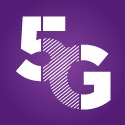May 8, 2019

DENVER -- Big 5G Event -- As 5G applications emerge, providing wired infrastructure to support mobile services will go far beyond just offering fiber, regional network operator CenturyLink says.
CenturyLink is already working with wireless operators that want to set up mobile edge computing, CTO Andrew Dugan said in an on-stage conversation at the Big 5G Event in Denver on Tuesday.
CenturyLink is a global provider of enterprise and residential broadband with an extensive fiber network. In addition to supporting 5G operators with fiber available for both macro and small cells, it has 3,500 sites with space and power where mobile carriers can deploy edge computing, Dugan said. That resource comes from the company's legacy as a telecommunications carrier, with facilities like a downtown Denver central office where ten floors were once filled with switches. Now, much of that space is free for customers' equipment, though it has needed retrofitting to meet growing power demands.
Mobile operators are part of the planned customer base for new fiber buildouts in Boulder, Colo., and other upcoming cities, he said. And with 5G, the market is not just growing but spreading out. "There's a lot of 5G suppliers that sort of come out of the woodwork once you start to say you're interested," Dugan said.
The company's Programmable Services Backbone for edge computing is deployed in tens of locations across the US, Dugan said. Customers are presenting deeper requirements for specialized services, such as video monitoring at retail stores for checkout, security or foot-traffic analytics. Robotics control in factories is another new application.
Companies looking for those kinds of services are asking for network latency of 10ms or less. End users in those companies would like 5ms, but that's not necessarily practical yet, Dugan said.
Software-defined networking and dynamic computing capacity now allows CenturyLink to help customers build and connect applications on demand within minutes, he said. Customers can choose anything from pure space and power in a facility to a fully managed service.
CenturyLink is also a 5G operator itself, though on a small scale. In the US, it's deploying fixed wireless access in some rural areas using elements of 5G. Dugan cautioned the audience that 5G is still radio, and sometimes it gives far different speeds to customers in the same area. "I think we just need to be realistic about what the technology can do," he said.
Why this matters
5G networks to serve advanced applications in transportation, industry and other fields will need more than strong RANs. Speed and latency requirements will demand a much more advanced back end than 4G networks in use today. Ample fiber infrastructure and edge computing resources will play key roles here, and third parties will provide those pieces in many cases. Fiber network providers like CenturyLink and Zayo will help to make reliable, low-latency and quickly deployed 5G services possible.
— Stephen Lawson, special to Light Reading. Follow him on Twitter @sdlawsonmedia.
You May Also Like

.jpeg?width=300&auto=webp&quality=80&disable=upscale)







